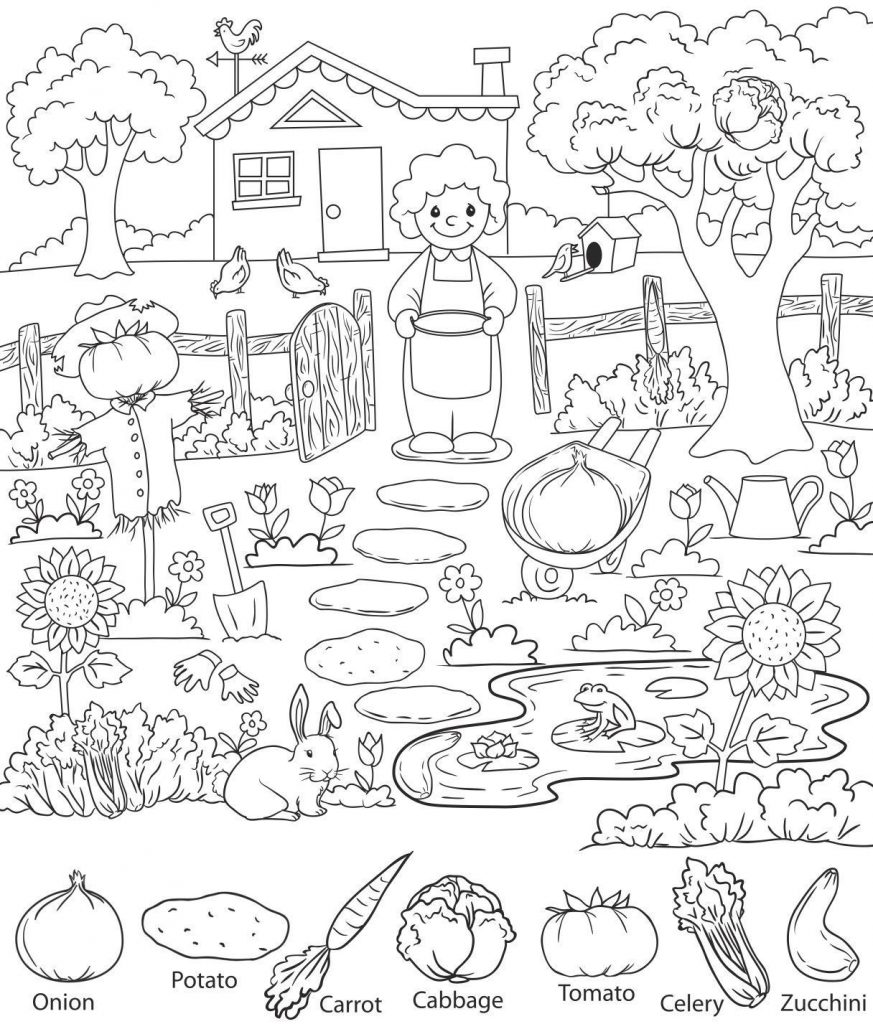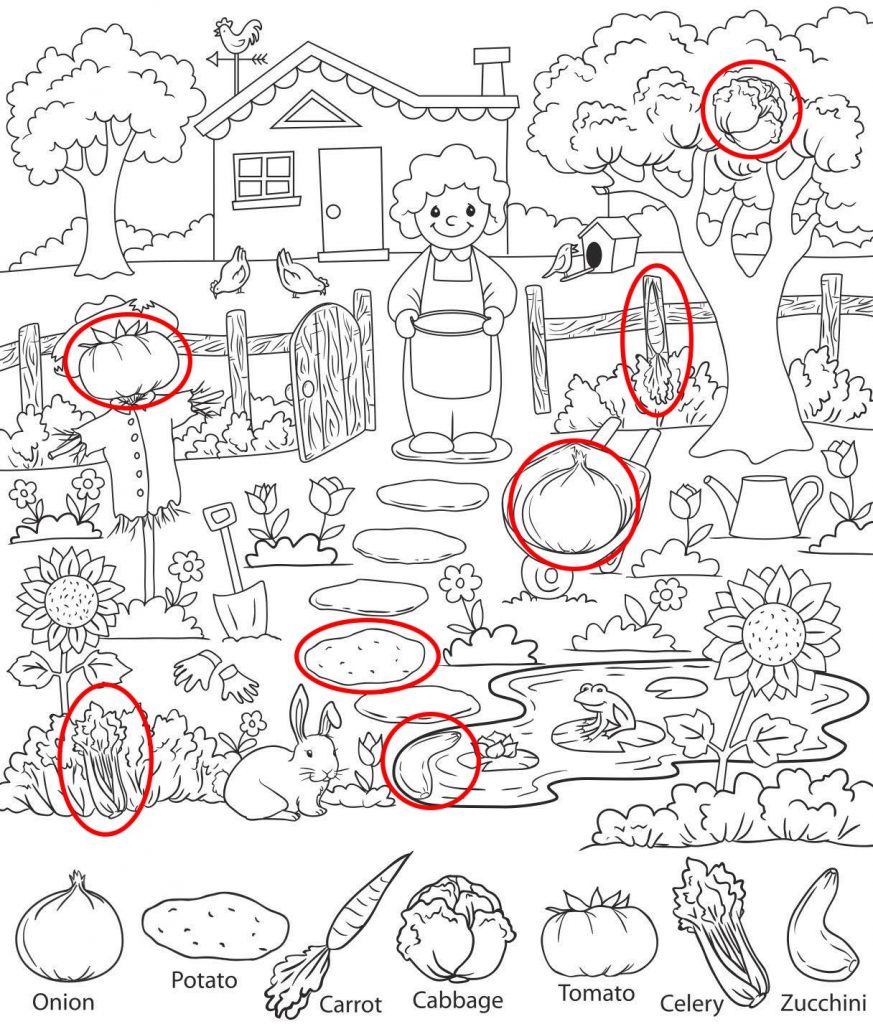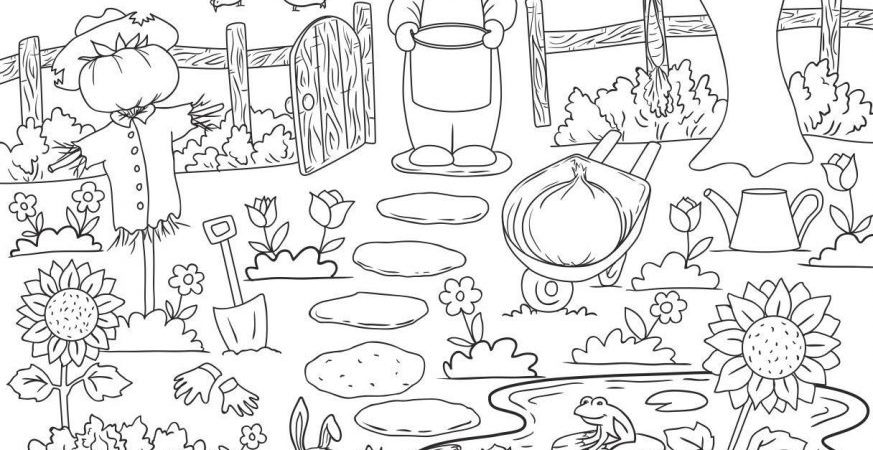Exploring the World of Garden Vegetables: A Hidden Object Puzzle Adventure
Gardening is one of the most rewarding and peaceful hobbies you can embrace, especially when you plant vegetables and witness them grow over time. The picture above captures the essence of this, showcasing a cheerful gardener tending to their vegetable garden. If you look closely, you’ll find a variety of vegetables such as onions, potatoes, carrots, and tomatoes, each adding color and life to the garden.
In this article, we will take a deep dive into the world of vegetables, exploring their unique qualities and offering a fun hidden object twist to this otherwise serene gardening scene.

Discovering the Vegetables in the Garden
The first thing that stands out in the image is the variety of vegetables being nurtured by the gardener. From root vegetables like carrots and potatoes to leafy greens like cabbage and celery, each plant brings a different flavor and texture to your garden and kitchen.
Onions: The Flavor Enhancer
Onions are a staple in many kitchens around the world. Known for their sharp, pungent flavor, onions are a key ingredient in many dishes, providing a base for soups, stews, sauces, and more. In the garden scene, the onion is placed strategically in the soil, its layers of skin wrapping tightly around the bulb. When planting onions, gardeners must choose between several varieties, including red, yellow, and white onions.
Potatoes: A Root Vegetable with Endless Possibilities
Potatoes are one of the most versatile vegetables, perfect for baking, frying, or mashing. In the picture, the potato lies hidden beneath the soil, symbolizing how this vegetable grows underground. The earthy, starchy vegetable is a perfect companion to many meals, from stews to french fries. When planted, potatoes need well-drained soil and plenty of space to grow, as each seed potato will yield a new crop.
Carrots: The Vibrant Orange Beauty
Carrots add a sweet and earthy flavor to dishes, and their vibrant orange color is a symbol of health and vitality. The carrots in the garden picture are easily recognizable, poking out of the soil with their distinct long and tapered shape. Carrots grow best in loose, sandy soil and thrive in cooler temperatures. Beyond their culinary uses, carrots are rich in beta-carotene, which is beneficial for eye health.

The Delight of Growing Leafy Greens
Vegetables like cabbage, celery, and zucchini bring color and texture to your garden, each offering unique health benefits. These vegetables are often found in the garden beds surrounding the primary crops, adding diversity to your vegetable patch.
Cabbage: A Cool-Season Crop
Cabbage, with its hearty leaves and crunchy texture, is perfect for winter gardening. The cabbage in the image stands tall with its tightly packed leaves, ready to be harvested for salads or soups. Cabbages are cool-season crops, meaning they grow best in the fall or spring. They are packed with nutrients like vitamin C, fiber, and folate, making them a great addition to any healthy diet.
Celery: A Nutritious and Versatile Green
Celery may seem like a humble vegetable, but it has impressive nutritional value. It’s known for being low in calories while providing a good source of vitamin K. Celery in the garden grows tall, with stalks rising from the soil, ready to be harvested for soups, salads, and even juices. Its crisp texture and slightly peppery taste make it an ideal addition to many dishes.
Zucchini: The Summer Favorite
Zucchini, often referred to as summer squash, grows rapidly during the warm months. The zucchini plant in the garden scene might be seen sprawling across the soil, producing vibrant, dark green fruits that are perfect for grilling, sautéing, or baking. Zucchini is an incredibly versatile vegetable, known for its mild flavor and high water content. It’s also a rich source of vitamins A and C, potassium, and fiber.

The Importance of a Garden’s Ecosystem
In the garden scene above, the gardener is not alone in the process of growing vegetables. There are animals like rabbits, birds, and frogs coexisting with the plants. These creatures contribute to the overall health of the garden, either by pollinating the plants or helping control pests.
Pollinators in the Garden: Bees and Butterflies
Bees and butterflies play a crucial role in the ecosystem by pollinating flowers. In a vegetable garden, pollination is essential for fruit-bearing plants like tomatoes and zucchini. While the gardener waters the plants, pollinators are hard at work ensuring that flowers bloom and produce fruit. Without these pollinators, many vegetables would not be able to reproduce.
Beneficial Animals: Frogs and Birds
Frogs and birds contribute to the health of the garden by controlling pests. Frogs are natural predators of insects like mosquitoes and flies, while birds help by eating pests that may damage the plants. These animals are crucial for maintaining a balanced ecosystem in your garden, preventing overgrowth of harmful pests and promoting healthy plant growth.

Gardening Tips: Growing Your Own Vegetables
Starting a vegetable garden like the one in the picture requires some planning and effort, but the rewards are well worth it. Whether you’re a seasoned gardener or a beginner, here are some tips to help you grow a successful garden:
Choose the Right Location
Most vegetables need plenty of sunlight, so choose a spot in your yard that receives at least six hours of sunlight per day. Ensure the area is well-drained, as most vegetables, like carrots and potatoes, don’t do well in soggy soil.
Prepare the Soil
Healthy soil is key to a successful garden. Before planting, test the soil to ensure it has the proper nutrients. Add compost or organic matter to improve soil fertility. If your soil is too heavy or clay-like, consider adding sand or organic mulch to help with drainage.
Watering and Maintenance
Water your vegetables regularly, but avoid overwatering. Most vegetables prefer deep watering sessions rather than shallow, frequent watering. Also, make sure to remove weeds regularly to ensure they don’t steal nutrients from your plants.
Harvesting at the Right Time
Harvest vegetables when they’re ripe, but don’t wait too long. Overripe vegetables can become tough or overly mature, making them less enjoyable to eat. Use sharp tools like garden shears to cut plants cleanly, avoiding damage to the roots or stems.

Conclusion: Gardening Brings Joy and Healthy Produce
From planting onions to harvesting tomatoes, gardening offers a rewarding experience for people of all ages. As we saw in the picture, the garden is full of life—vegetables, animals, and happy gardeners working together to nurture a thriving ecosystem. Whether you’re growing your own vegetables to improve your diet or simply enjoying the beauty of nature, gardening provides a sense of accomplishment and connection to the earth.
So, the next time you look at a garden, remember the hidden treasures that await in the soil. And, whether you’re solving a hidden object puzzle or getting your hands dirty in the garden, it’s all about the joy of discovery and growth.
